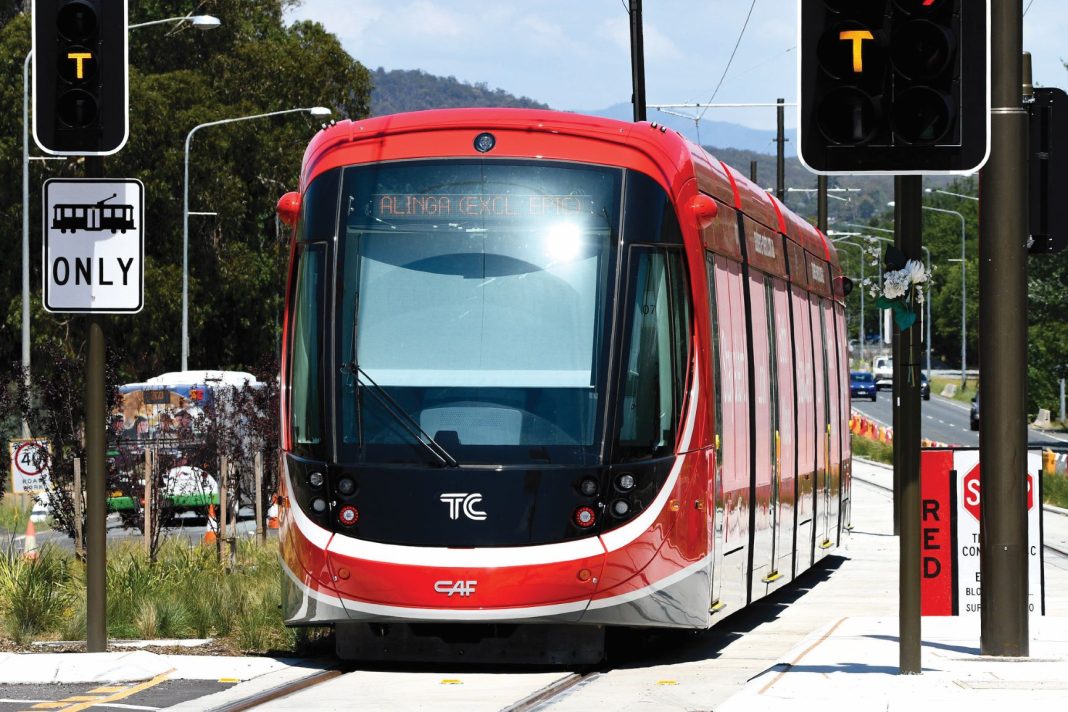Five Years On: Benefits Realisation of Light Rail Stage 1, a five-year analysis published by Transport Canberra, the ACT Government department responsible for public transport, states that light rail supports the construction of more housing, increases public transport patronage, and reduces congestion.
Light rail began operating on 20 April 2019, and celebrated its five-year anniversary last month.
Since then, according to the report, 16.5 million passenger trips have been made on board light rail; light rail vehicles have travelled more than 4.5 million kilometres; 99.98 per cent of light rail services are delivered and run on time.
Light rail maintains a roughly 20 per cent share of all public transport patronage in the ACT; 43 per cent of passengers had not previously used the bus network, which the government says demonstrates the power of light rail in attracting passengers to public transport; and 95 per cent of passengers are satisfied with the service.
Road count data at high use areas along the light rail corridor demonstrates a significant reduction of motor vehicle travel. At a single location, the Northbourne Avenue and Macarthur Avenue intersection, light rail has contributed to a total daily volume reduction of 21 per cent in 2019 and 18 per cent this March, compared to 2016.
Since January 2016, approximately $2.3 billion in construction has been given development approval (or currently under consideration by the Authority) in suburbs directly adjacent the Light Rail Stage 1, and 6,100 new dwellings have been built along the light rail corridor.
Business growth has increased by 26.4 per cent in Gungahlin suburbs along the corridor from 2018-2022 and by 19.7 per cent in the City suburbs along the corridor over the same period.
“Light rail has delivered billions in additional construction work along the alignment, thousands of new homes and thousands of local jobs,” said Chris Steel, Minister for Transport.
“It’s clear that this is the preferred mode of public transport that Canberrans wish to use, with more and more people in our city choosing to live along the alignment.
“Business growth along the corridor has also increased with the largest benefit occurring in Gungahlin and suburbs adjacent to the city centre.
“Our first mass-transit system, through the delivery of Stage 1 of Light Rail, represented a vision for Canberra as a connected, sustainable and vibrant city.
“The evidence outlined in this report realises that vision and supports our decision to deliver future stages of the project.”
Ryan Hemsley, chair of the Public Transport Association of Canberra (PTCBR), said: “This report confirms what we’ve known all along – light rail is the best thing to happen to our public transport system in a long time. It attracts new passengers, incentivises urban renewal, and gets cars off the road.
“More importantly, it confirms that we cannot afford any delays in rolling out light rail to the rest of Canberra. It offers concrete benefits for all Canberrans, regardless of whether they use public transport, and will continue to shape our city for the better.
“Light rail is a core element of our city’s liveability now and into the future. Let’s build more of it.”
The ACT Government is building a light rail network from City to Woden, which is expected to be completed by 2033. Mr Steel said this north-south public transport spine for Canberra, which will continue to expand over the coming years, will connect employment, residential and commercial hubs.
“While this report recognises the significant initial contribution of light rail stage 1 to our city, those benefits will continue with the operation and future stages of this service,” Mr Steel said.
“This is evidenced by a clear appetite by both business and the community to deliver this important city-shaping project, that provides thousands of local jobs, supports the construction of more homes, removes congestion from our roads and encourages more people to take public transport.
“We will continue to invest in this important city shaping infrastructure that will benefit Canberrans for generations to come.”
However, an independently published report, 21st Century Public Transport Solutions for Canberra, published in February, warned that the government should not proceed light rail stage 2B – an enormous expense to service less than 10 per cent of Canberra’s commuting public – and instead adopt alternative solutions such as electric buses or a trackless tram system.
Likewise, the Canberra Liberals oppose light rail stage 2, which they calculate will be an “economic disaster”, costing more than $5 billion.
“The major difference,” shadow transport minister Mark Parton said last month, “is that when this government chose to build a tram from Gungahlin to the city, they were solving a genuine public transport problem between Gungahlin and Civic. There is no public transport problem between Woden and Civic, none at all. They’re just creating one.”
ACT Greens transport spokeswoman Jo Clay said: “The ACT Greens were the first party to back the light rail, and today we’ve seen yet more evidence of what an overwhelming success it has been over the past five years.
“Canberrans love the high-quality, zero-emissions transport brought by the light rail from the city to Gungahlin.
“We now must make sure we share the love with Canberra’s south.
“ACT Labor says we can’t roll it out to Woden until 2033, but the Greens won’t just sit back and accept that.
“From examples such as the Gold Coast, we know the government can do more to speed up this process and bring forward planning and building of stages 2A and 2B.”


